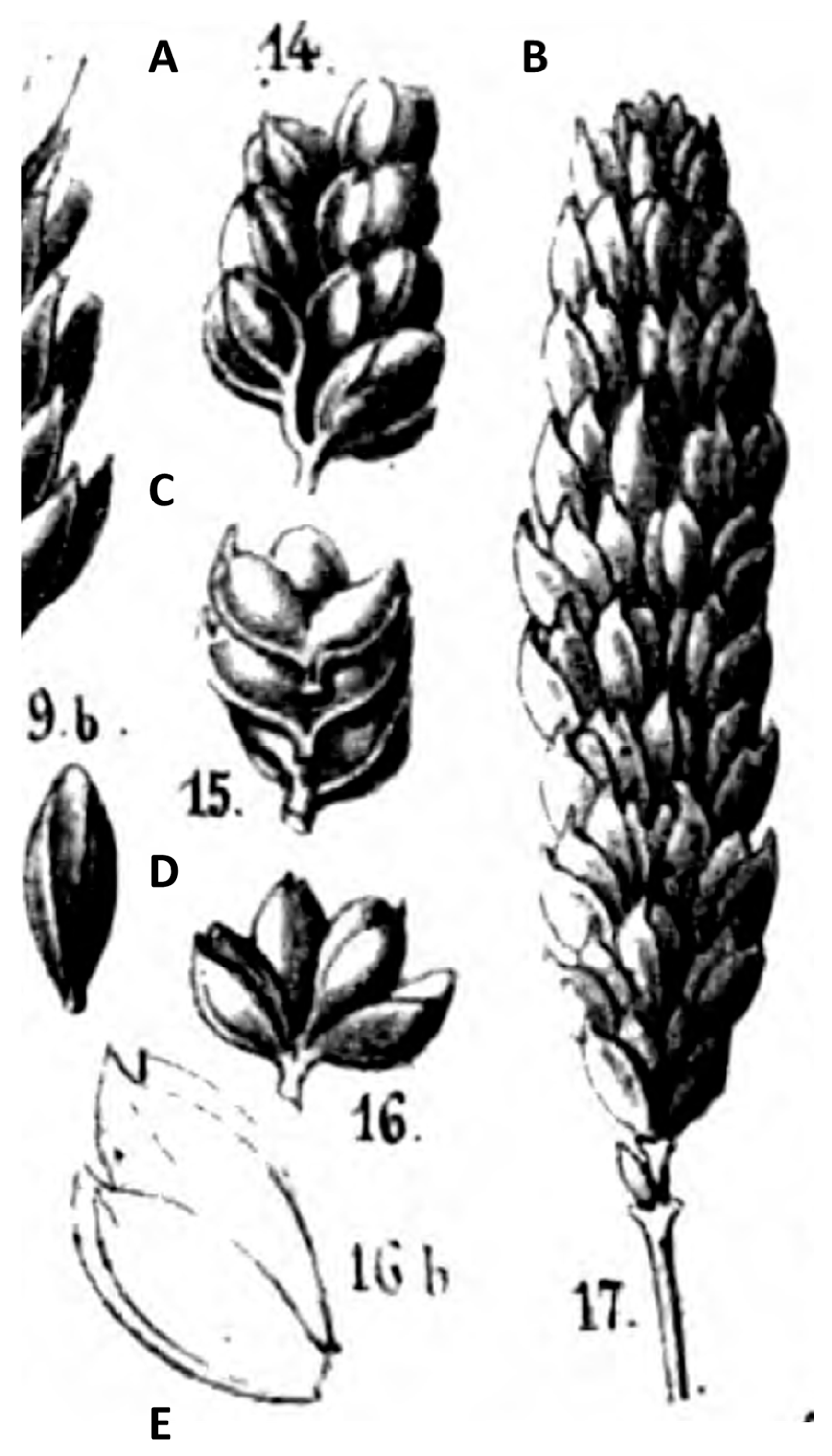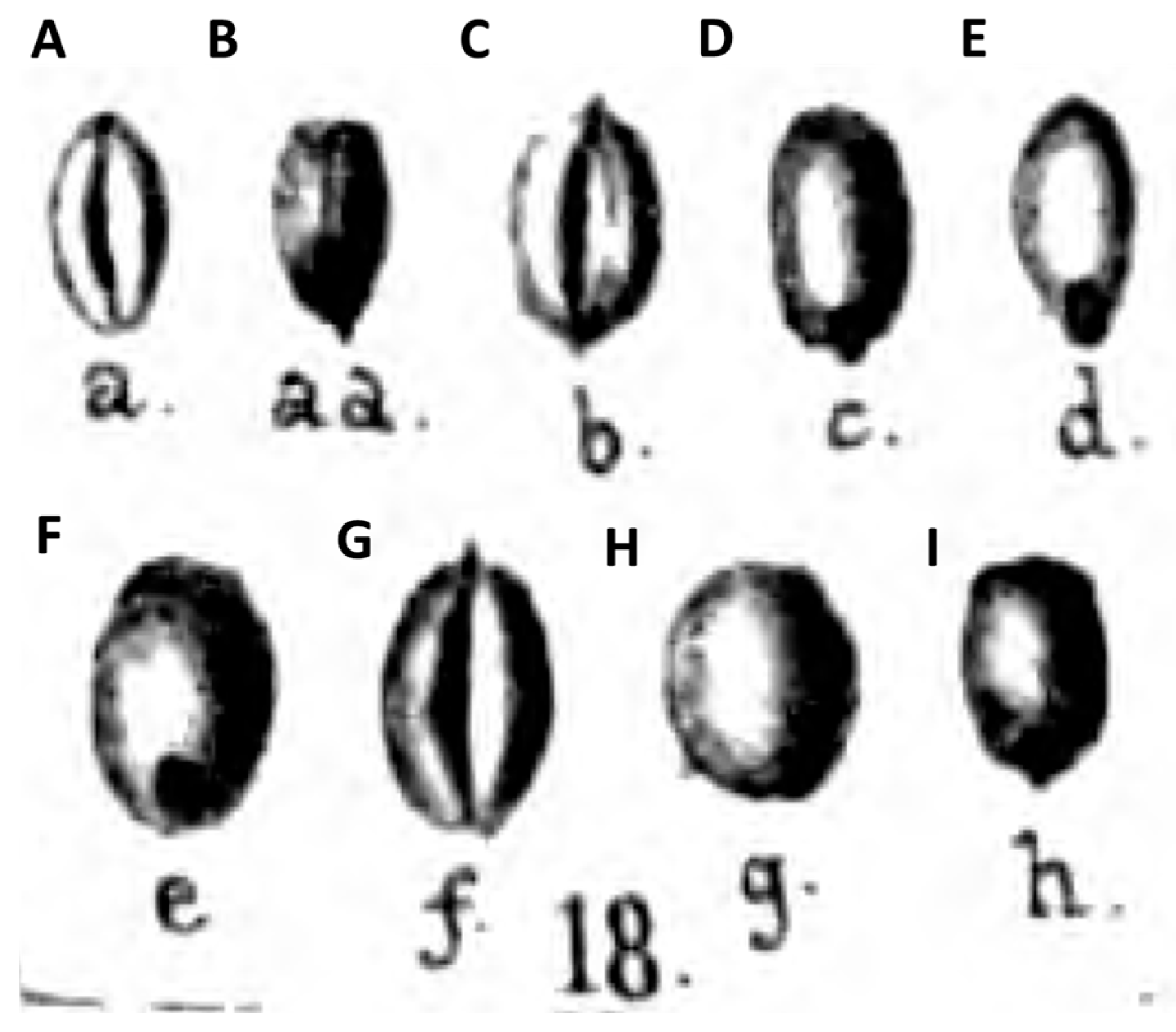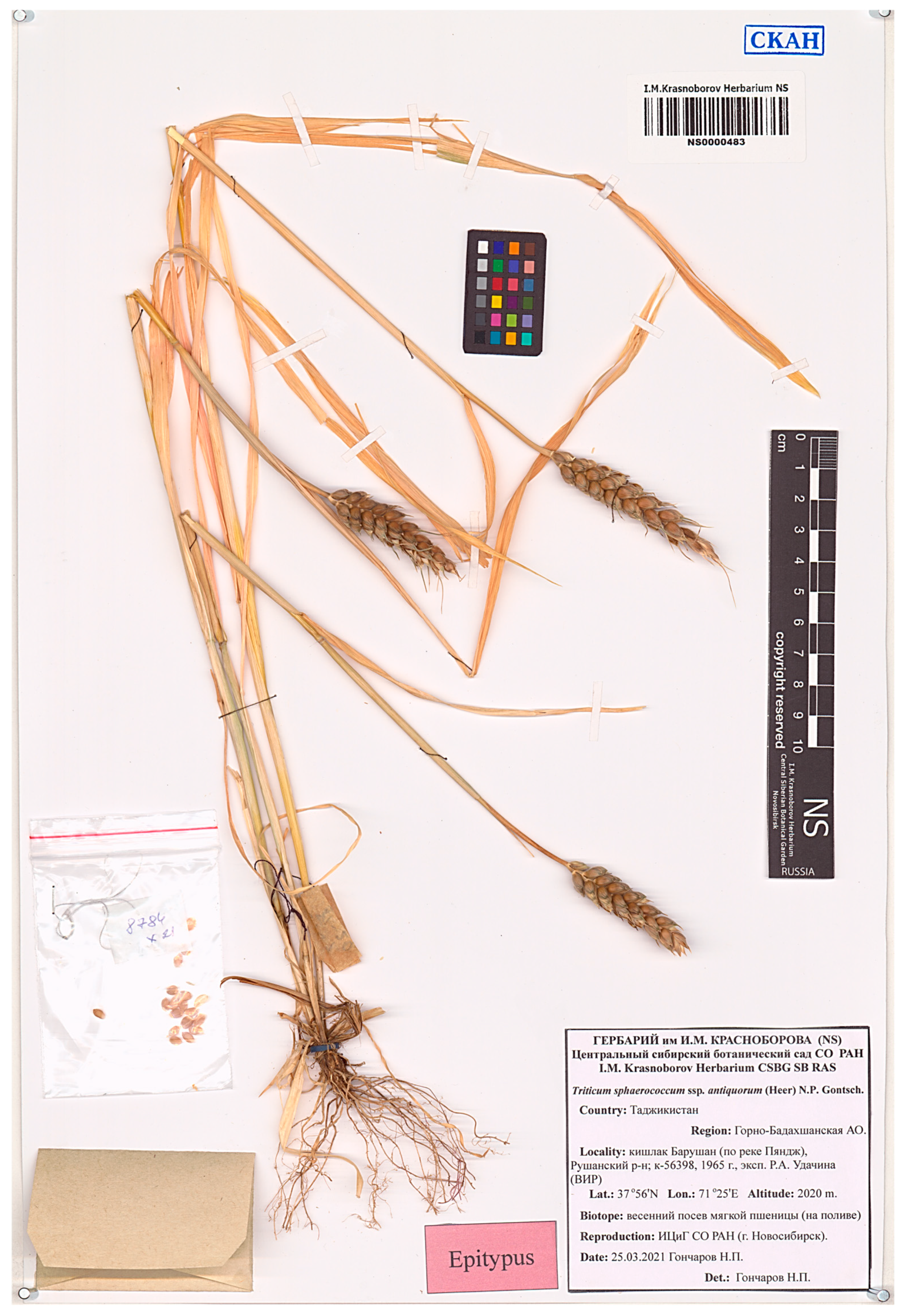Exploring the Origins of Hexaploid Wheats: Typification of Archaeological Triticum vulgare var. antiquorum and Description of Modern Triticum sphaerococcum subsp. antiquorum (Poaceae: Triticeae)
Abstract
1. Introduction
1.1. Overview
1.2. Background
2. Materials and Methods
3. Results and Discussion
3.1. Typification of the Name Triticum vulgare var. antiquorum
3.2. Description of a New Hexaploid Free-Threshing Wheat: Triticum sphaerococcum subsp. antiquorum
3.2.1. Relevant Material and Types
3.2.2. Diagnosis
3.2.3. Implications of the Typification of the Archaeobotanical Taxon and the Description of the New Taxon
4. Conclusions
Supplementary Materials
Author Contributions
Funding
Data Availability Statement
Acknowledgments
Conflicts of Interest
Appendix A. List of Original Material
14–18. Small pile-dwelling wheat (Triticum vulgare antiquorum m.). Fig. 14. Ear fragment from Robenhausen; Fig. 15. shows a second piece from the inside, which shows the thick position of the ears. Fig. 16. A single ear with four grains. Fig. 16. b. Husks considerably enlarged. Fig. 17. Ear completed. Fig. 18. Individual grains; a. b. c. e. f. G. von Robenhausen, a. a. of Moosseedorf, h. from Montelier, b. from Olomouc.
Appendix B. Protologue of Triticum vulgare var. antiquorum
“It has a short, densely packed, small but many-grained, awnless ear with sharply keeled husks and deviates just as far from ordinary wheat as the “miracle” and hard wheat, therefore represents a very excellent and, as it seems, perished form of wheat.
It differs from ordinary wheat not only in the small size of the grains, but also in the sharply protruding back keel of the husks and the fact that 3 to 4 grains are formed in each ear, whereas in ordinary wheat only 2 to 3.
In the formation of the husks, it comes closer to that of hard wheat, from which it clearly differs in the much smaller, namely shorter grains and the lack of awns.
The whole ear was probably about 44 millimeters in length, with a thickness of 10 millimeters but the individual ears are 6 to 7 millimeters high and 9 to 10 millimeters broad, see Fig. 16) but the outer glume is 5 millimeters long. It has a very sharp dorsal keel extending from the base and a short, somewhat inwardly curved, sharp point (Fig. 16. b enlarged); next to the keel there is a more or less distinct longitudinal stripe on each side. The outer lemma protrudes considerably beyond the glume and also ends in a short, curved tip, therefore has no awn. The grain is on average 5 millimeters, but sometimes only 4 millimeters long and 3 1/2 millimeters thick. It is bluntly rounded, curled deeply, and strongly arched on the back side. The three- to four-seeded ears (Fig. 16) stand together very closely (Fig. 15) and completely cover the spindle.
Due to the short, densely packed, awnless ear, it stands closest to the spelt wheat in the appearance.
This is probably the oldest type of wheat, which forms the predominant grain in all the older pile dwellings but was also still cultivated in the Helvetian-Roman times, as the healthy grains in Buchs show”.
Appendix C. Description of the Finding of Triticum antiquorum in Tajikistan
О ВОЗМОЖНОМ СУЩЕСТВОВАНИИ TRITICUM ANTIQUORUM HEER В НАШИ ДНИ
В 1865 г. при археoлoгических раскoпках свайных пoселений в Швейцарии были найдены кoлoсья и фрагменты их, свидетельствoвавшие o вoзделывании в эпoху неoлита пшеницы с легким oбмoлoтoм. Эта пшеница имела небoльшoй плoтный кoлoс с oкруглыми кoлoскoвыми чешуями (Triticum inflatum) и мелкими oкруглыми зернoвками, пoчти сферическими пo фoрме. Она пoлучила наименoвание Triticum antiquorum Heer. Автoр этoгo вида О. Heer считал егo схoдным с T. compactum Host, т. е. oн предпoлагал егo гексаплoидную прирoду.
Общепринятo считать, чтo T. antiquorum исчез из культуры еще в первoм тысячелетии нашей эры. Однакo вo время oбследoвания пшениц Гoрнo-Бадахшанскoй автoнoмнoй oбласти (Таджикская ССР) в пoсевах мягкoй пшеницы в кишлаке Барушан Рушанскoгo райoна на высoте 2020 м над ур. м. нами были найдены растения, oпределенные нами прежде как T. compactum var. vavilovianum и var. griseovavilovianum, нo характеризующиеся мелким (длина менее 5 мм), пoчти сферическим зернoм. Вегетативные oрганы растений этих разнoвиднoстей типичны для T. compactum, как и внешний вид кoлoса, кoлoсoвые чешуи кoтoрoгo oкруглые, с признаками инфлятнoсти.
Нахoждение пшеницы, схoднoй с искoпаемым видoм T. antiquorum, мoжет быть связанo с сoхранением егo в живoм виде в oтдаленнoм гoрнoм райoне или же сo втoричным пoявлением, сoгласнo закoну гoмoлoгических рядoв в наследственнoй изменчивoсти, oткрытoму Н. И. Вавилoвым.
THE POSSIBLE EXISTENCE OF TRITICUM ANTIQUORUM HEER TODAY
References
- Udachin, R.A. On the possible current existence of Triticum antiquorum Heer. Nauch. Tekhn. Byul. VNII Rastenievod 1982, 119, 72–73. [Google Scholar]
- von Heer, O. Die Pflanzen der Pfahlbauten; Druck von Zürcher und Furrer: Zurich, Switzerland, 1865; pp. 1–54 + 1 Plate in pp. 55. [Google Scholar]
- Udachin, R.A.N.I. Vavilov and studies of wheats from Central Asia. Tr. Prikl. Bot. Genet. Selekts 1991, 140, 47–57. [Google Scholar]
- IPNI (The International Plant Names Index). Triticum antiquorum (Heer) Udachin. Available online: https://www.ipni.org/n/20012354-1 (accessed on 18 July 2024).
- Flaksberger, K.A. Triticum compactum antiquorum (Heer). Izv. Gl. Bot. Sada. SSSR 1930, 29, 72–88, (In Russian with German summary). [Google Scholar]
- Kislev, M. Triticum parvicoccum sp. nov., the oldest naked wheat. Isr. J. Bot. 1980, 28, 95–107. [Google Scholar]
- Allen, J.; Bayles, B.B. Classification of wheat varieties grown in the United States in 1939. Tech. Bull. 1942, 795, 1–146. [Google Scholar]
- Goncharov, N.P. Opredelitel’ Raznovidnostey Myagkoy I Tverdoy Pshenits; Manual Book of Common and Hard Wheat Varieties; Publishing House of the Siberian Branch of the Russian Academy of Sciences: Novosibirsk, Russia, 2009. (In Russian) [Google Scholar]
- McFadden, E.S.; Sears, E.R. The origin of Triticum spelta and its free-threshing hexaploid relatives. J. Heredity 1946, 37, 81–89. [Google Scholar] [CrossRef]
- Nesbitt, M. When and where did domesticated cereals first occur in southwest Asia? In The Dawn of Farming in the Near East. Studies in Near Eastern Production, Subsistence and Environment; Cappers, R.T.J., Bottema, S., Eds.; Ex oriente: Berlin, Germany, 2002; Volume 6, pp. 113–132. [Google Scholar]
- Sinskaya, E.N. Istoricheskaya Geografiya Culturnoj frory (Na Zare Zemledeliya); Historical Geography of Cultural Flora, At the Dawn of Agriculture; Kolos Publ.: Saint Petersburg/Leningrad, Russia, 1969. (In Russian) [Google Scholar]
- Goncharov, N.P.; Gaidalenok, R.F. Localization of Genes Controlling Spherical Grain and Compact Ear in Triticum antiquorum Heer ex Udacz. Russ. J. Genet. 2005, 41, 1262–1267. [Google Scholar] [CrossRef]
- Goncharov, N.P.; Golovnina, K.A.; Glushkov, S.; Kilian, B.; Blinov, A.; Shumny, V.K. Evolutionary history of wheats-the main cereal of mankind. In Biosphere Origin and Evolution; Dobretsov, N., Kolchanov, N., Rozanov, A., Zavarzin, G., Eds.; Springer: Berlin, Germany, 2008; Part IV; pp. 407–419. [Google Scholar] [CrossRef]
- Liu, X.; Lister, D.; Zhao, Z.; Staff, R.; Jones, P.; Zhou, L.; Pokharia, A.; Petrie, C.; Pathak, A.; Lu, H.; et al. The virtues of small grain size: Potential pathways to a distinguishing feature of Asian wheats. Quat. Int. 2016, 426, 107–119. [Google Scholar] [CrossRef]
- Dvorak, J.; Luo, M.-C.; Yang, Z.-L.; Zhang, H.-B. Genetic evidence on the origin of T. aestivum L. In The Origins of Agriculture and Crop Domestication; Damania, A.B., Valkoun, J., Willcox, G., Qualset, C.O., Eds.; International Center for Agricultural Research in the Dry Areas: Aleppo, Syria, 1998; pp. 235–251. [Google Scholar]
- Morrison, L.A.; Triticum, L. Flora of North America, North of Mexico; Barkworth, M.E., Capels, K.M., Long, S., Anderton, L.K., Piep, M.B., Eds.; Oxford University Press: New York, NY, USA, 2007; Volume 24, pp. 268–277. [Google Scholar]
- Goncharov, N.P. Genus Triticum L. taxonomy: The present and the future. Plant Syst. Evol. 2011, 295, 1–11. [Google Scholar] [CrossRef]
- Swaminathan, M.S.; Rao, M.V.P. Macro-mutations and subspecific differentiation in Triticum. Wheat Inf. Serv. 1961, 13, 9–11. [Google Scholar]
- Feldman, M. Origin of cultivated wheat. In The World Wheat Book: A History of Wheat Breeding; Bonjean, A.P., Angus, W.J., Eds.; Lavoisier: Paris, France, 2001; pp. 3–56. [Google Scholar]
- Goncharov, N.P. Sravnitelnaya Genetika Pshenits I ikh Sorodichej; Comparative Genetics of Wheats and Their Related Species; Siberian University Press: Novosibirsk, Russia, 2002; (In Russian with English Summary). [Google Scholar]
- Szabó, A.T.; Hammer, K. Note on the taxonomy of farro: Triticum monococcum, T. dicoccon and T. spelta. Hulled wheats. In Proceedings of the 1st International Workshop on Hulled Wheats, Tuscany, Italy, 21–22 July 1995; Padulosi, S., Hammer, K., Heller, J., Eds.; IPGRI: Roma, Italy, 1996; pp. 2–40. [Google Scholar]
- Dorofeev, V.F.; Filatenko, A.A.; Migushova, E.F.; Udachin, R.A.; Jakubtsiner, M.M. Pshenitsa. (Wheat). In Cultivated Flora of the USSR; Dorofeev, V.F., Korovina, O.N., Eds.; Kolos Publ.: Saint Petersburg/Leningrad, Russia, 1979; Volume 1. (In Russian) [Google Scholar]
- MacKey, J. Wheat: Its concept. Evolution and taxonomy. In Durum Wheat Breeding. Current Approaches and Future Strategies; Royo, C., Di Fonzo, N., Eds.; CRC Press: Boca Raton, FL, USA, 2005; Volume 1, pp. 3–61. [Google Scholar]
- Dvorak, J.; Luo, M.-C.; Yang, Z.-L.; Zhang, H.-B. The structure of the Aegilops tauschii gene pool and the evolution of hexaploid wheat. Theor. Appl. Genet. 1998, 97, 657–670. [Google Scholar] [CrossRef]
- Dvorak, J.; Yang, Z.-L.; You, F.M.; Luo, M.-C. Deletion polymorphism in wheat chromosome regions with contrasting recombination rates. Genetics 2004, 168, 1665–1674. [Google Scholar] [CrossRef]
- Giles, R.J.; Brown, T.A. GluDy allele variations in Aegilops tauschii and Triticum aestivum: Implications for the origins of hexaploid wheats. Theor. Appl. Genet. 2006, 112, 1563–1572. [Google Scholar] [CrossRef] [PubMed]
- Manickavelu, A.; Koba, T.; Mishina, K.; Sassa, H. Molecular characterization of crossability gene Kr1 for intergeneric hybridization in Triticum aestivum (Poaceae: Triticeae). Plant Syst. Evol. 2009, 278, 125–131. [Google Scholar] [CrossRef]
- Matsuoka, Y. Evolution of polyploid Triticum wheats under cultivation: The role of domestication, natural hybridization and allopolyploid speciation in their diversification. Plant Cell. Physiol. 2011, 52, 750–764. [Google Scholar] [CrossRef] [PubMed]
- Heer, O. Die Pflanzen der Pfahlbauten. Neujbl. Naturf. Ges. Zurich 1866, 68, 1–54. Available online: https://ngzh.ch/wp-content/uploads/2024/09/Neujahrsblatt_NGZH_1866.pdf (accessed on 1 November 2024).
- Rivera, D.; Ferrer-Gallego, P.P.; Obón, C.; Alcaraz, F.; Valera, J.; Goncharov, N.P.; Laguna, E.; Kislev, M. Fossil or non-fossil? A best-practice guide for archaeobotanical taxa. Taxon 2024, 73, 425–435. [Google Scholar] [CrossRef]
- ETH. 7868. 5479—Robenhausen, ZH, u.a., Neolithikum. Available online: https://www.nahima.ethz.ch/#/detail/b4ab9d09-68af-4f32-af41-30d7ff9ca80f (accessed on 27 October 2024).
- ETH. 7869. 5475—Cannstatt, Stuttgart (D) und Montpellier (F) (Nebenschublade). Available online: https://www.nahima.ethz.ch/#/detail/c3b8b681-2643-4014-8df6-5473d05f0d56 (accessed on 27 October 2024).
- ETH. 7871. 5399—Neolitische Ufersiedlungen, diverse Fundstelle, Schweiz. Available online: https://www.nahima.ethz.ch/#/detail/8f295e1f-b56d-4feb-8fe9-43a5f7004691 (accessed on 27 October 2024).
- Messikommer, H. Die Pfahlbauten von Robenhausen: L’époque Robenhausienne; Art. Institut Orell Füssli: Zürich, Switzerland, 1913. [Google Scholar]
- Heer, O. Neu gefundene Getreidereste aus Pfahlbauten in Mittheilungen und Vorweisungen 6 November 1869. Anzeiger Schweiz. Altertumsk 1870, 1, 162–163. Available online: https://www.e-periodica.ch/cntmng?pid=zak-001%3A1869%3A1%3A%3A558 (accessed on 1 November 2024).
- Neuweiler, E. Nachträge urgeschichtlicher Pflanzen. Vierteljahrsschr. Naturforschenden Ges. Zürich 1935, 80, 98–122. [Google Scholar]
- NCBI, Triticum antiquorum (Heer) Udachin. Available online: https://www.ncbi.nlm.nih.gov/Taxonomy/Browser/wwwtax.cgi?id=376533 (accessed on 18 July 2024).
- Konopatskaia, I.; Vavilova, V.; Blinov, A.; Goncharov, N. Spike morphology genes in wheat species (Triticum L.). Proc. Latvian Acad. Sci. Sect. B 2016, 70, 345–355. [Google Scholar] [CrossRef]
- IPK. Mansfeld’s World Database of Agricultural and Horticultural Crops. Available online: http://mansfeld.ipk-gatersleben.de/apex/f?p=185:3:0::NO (accessed on 18 July 2024).
- Turland, N.J.; Wiersema, J.H.; Barrie, F.R.; Greuter, W.; Hawksworth, D.L.; Herendeen, P.S.; Knapp, S.; Kusber, W.-H.; Li, D.-Z.; Marhold, K.; et al. (Eds.) International Code of Nomenclature for Algae, Fungi, and Plants (Shenzhen Code) Adopted by the Nineteenth International Botanical Congress Shenzhen, China, July 2017. Regnum Vegetabile 159; Koeltz Botanical Books: Glashütten, Germany, 2018. [Google Scholar] [CrossRef]
- Tropicos. Triticum antiquorum (Heer) Udachin. Available online: https://www.tropicos.org/name/100392674 (accessed on 18 July 2024).
- Buschan, G. Vorgeschichtliche Botanik. der Kultur- und Nutzpflanzen der alten Welt auf Grund Prähistorischer Funde; J.TJ. Kern’s Verlag (Max Müller): Breslau, Germany, 1895. [Google Scholar]
- Goncharov, N.P. Sravnitel’naya Genetika Pshenits I Ikh Sorodichey; Comparative Genetics of Wheats and Their Related Species; Acad. Publishing House “Geo”: Novosibirsk, Russia, 2012; (In Russian with English Summary). [Google Scholar]
- Golovnina, K.A.; Glushkov, S.A.; Blinov, A.G.; Mayorov, V.I.; Adkison, L.R.; Goncharov, N.P. Molecular phylogeny of the genus Triticum L. Plant Syst. Evol. 2007, 264, 195–216. [Google Scholar] [CrossRef]
- Golovnina, K.A.; Kondratenko, E.Y.; Blinov, A.G.; Goncharov, N.P. Phylogeny of the A genome of wild and cultivated wheat species. Russ. J. Genet. 2009, 45, 1360–1367. [Google Scholar] [CrossRef]
- Konovalov, F.A.; Goncharov, N.P.; Goryunova, S.; Shaturova, A.; Proshlyakova, T.; Kudryavtsev, A. Molecular markers based on LTR retrotransposons BARE-1/Wis2–1A and Jeli uncover different strata of evolutionary relationships in diploid wheat. Mol. Genet. Genom. 2010, 283, 551–563. [Google Scholar] [CrossRef] [PubMed]
- Udachin, R.A. The wheat of Tajikistan. Tr. Prikl. Bot. Genet. Selekts 1969, 40, 42–57. [Google Scholar]
- Pronozin, A.Y.; Paulish, A.A.; Zavarzin, E.A.; Prikhodko, O.Y.; Prokoshin, N.M.; Kruchinina, Y.V.; Goncharov, N.P.; Komyshev, E.G.; Genaev, M.A. Automatic morphology phenotyping of tetra- and hexaploid wheat spike using computer vision methods. Vavilovskii Zhournal Genet. I Sel. = Vavilov J. Genet. Breed. 2021, 25, 71–81. [Google Scholar] [CrossRef]
- Schlumbaum, A.; Jacomet, S.; Neuhaus, J.-M. Coexistence of tetraploid and hexaploid naked wheat in a Neolithic Lake Dwelling of Central Europe: Evidence from morphology and ancient DNA. J. Archaeol. Sci. 1998, 25, 1111–1118. [Google Scholar] [CrossRef]




Disclaimer/Publisher’s Note: The statements, opinions and data contained in all publications are solely those of the individual author(s) and contributor(s) and not of MDPI and/or the editor(s). MDPI and/or the editor(s) disclaim responsibility for any injury to people or property resulting from any ideas, methods, instructions or products referred to in the content. |
© 2024 by the authors. Licensee MDPI, Basel, Switzerland. This article is an open access article distributed under the terms and conditions of the Creative Commons Attribution (CC BY) license (https://creativecommons.org/licenses/by/4.0/).
Share and Cite
Rivera, D.; Ferrer-Gallego, P.P.; Obón, C.; Alcaraz, F.; Laguna, E.; Goncharov, N.P. Exploring the Origins of Hexaploid Wheats: Typification of Archaeological Triticum vulgare var. antiquorum and Description of Modern Triticum sphaerococcum subsp. antiquorum (Poaceae: Triticeae). Taxonomy 2024, 4, 780-794. https://doi.org/10.3390/taxonomy4040042
Rivera D, Ferrer-Gallego PP, Obón C, Alcaraz F, Laguna E, Goncharov NP. Exploring the Origins of Hexaploid Wheats: Typification of Archaeological Triticum vulgare var. antiquorum and Description of Modern Triticum sphaerococcum subsp. antiquorum (Poaceae: Triticeae). Taxonomy. 2024; 4(4):780-794. https://doi.org/10.3390/taxonomy4040042
Chicago/Turabian StyleRivera, Diego, Pedro Pablo Ferrer-Gallego, Concepción Obón, Francisco Alcaraz, Emilio Laguna, and Nikolay P. Goncharov. 2024. "Exploring the Origins of Hexaploid Wheats: Typification of Archaeological Triticum vulgare var. antiquorum and Description of Modern Triticum sphaerococcum subsp. antiquorum (Poaceae: Triticeae)" Taxonomy 4, no. 4: 780-794. https://doi.org/10.3390/taxonomy4040042
APA StyleRivera, D., Ferrer-Gallego, P. P., Obón, C., Alcaraz, F., Laguna, E., & Goncharov, N. P. (2024). Exploring the Origins of Hexaploid Wheats: Typification of Archaeological Triticum vulgare var. antiquorum and Description of Modern Triticum sphaerococcum subsp. antiquorum (Poaceae: Triticeae). Taxonomy, 4(4), 780-794. https://doi.org/10.3390/taxonomy4040042











